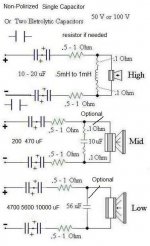You are welcome, the little Sica does well in a low diffraction cabinet. I am a little surprised by the overall directivity, 5dB flat from 250 to 1K without any active directivity control and a nice controlled rise up to 5K, I wasn't expecting that. Has me contemplating 10" woofers to go with my 6.5" coax. The love child of a B&W 802 and TAD Reference One 🙂@Thanks a lot fluid.. I am definitely going to try out this one..
Just waiting for my amp for the mids to arrive.. so far i have had only 2 amps... So I bought a small 3rd one for testing.. just a few more days.. 😀
A subtle change you can try as it's active is to add a 1st order low pass higher up to bring down the woofer breakup even more and then take out the delay that was in before.

@fluid : I made the change in crossover and got this response:


Now I am impatiently waiting to get the amp to try out all this.
Also, can you please explain about if you were choosing 10inch woofers for an application like this, how would you choose. What kind of traits you would like the woofer to have? in terms of cone material, motor, power handling, break up modes, low frequency extension etc.. I am curious about the overall driver selection process much more these days.. 😀
In the meanwhile, I also took impedance plots of the Sica mid in cabinet. This is because of the curiosity to know about what has happened to the impedance bumps in the 100-200Hz region. Here are the before putting the driver in the cabinet (left pic) and after putting the driver in the cabinet pics(right pic) :

It seems like something has caused the wiggles to go down quite a bit.. 😀
Now I am impatiently waiting to get the amp to try out all this.
Also, can you please explain about if you were choosing 10inch woofers for an application like this, how would you choose. What kind of traits you would like the woofer to have? in terms of cone material, motor, power handling, break up modes, low frequency extension etc.. I am curious about the overall driver selection process much more these days.. 😀
In the meanwhile, I also took impedance plots of the Sica mid in cabinet. This is because of the curiosity to know about what has happened to the impedance bumps in the 100-200Hz region. Here are the before putting the driver in the cabinet (left pic) and after putting the driver in the cabinet pics(right pic) :
It seems like something has caused the wiggles to go down quite a bit.. 😀
Last edited:
It is before and after what changes?
To me it looks like you had a mode who changed freq/severity.
Is there some damping material change? Could be the material too, selfdamping characteristics.
The Sica behavior is indeed very nice.
To me it looks like you had a mode who changed freq/severity.
Is there some damping material change? Could be the material too, selfdamping characteristics.
The Sica behavior is indeed very nice.
@krivium : I meant before putting the driver in the cabinet and after putting the driver in the cabinet.. 😀
Left pic in above post is with bare driver kept on a piece of xps foam. RIght pic is after putting the driver in the cabinet.
The cabinet is lined inside with aluminium-butyl sheet and also has melamine foam strips at the back of the cabinet and at other places. 🙂
Impedance measurement with driver in the cabinet (full pic)

Left pic in above post is with bare driver kept on a piece of xps foam. RIght pic is after putting the driver in the cabinet.
The cabinet is lined inside with aluminium-butyl sheet and also has melamine foam strips at the back of the cabinet and at other places. 🙂
Impedance measurement with driver in the cabinet (full pic)
You could try ksingle speaker mono setup. That is also easier, perhaps, to evaluate changes between xo variations.Now I am impatiently waiting to get the amp to try out all this.
@tmuikku : I only have a mono speaker set up now. 🙂
The second enclosure for coax is not even printed.
Problem that I have is. I have a six channel dsp of which I can use 3 channels for the mono speaker.
But I have only 3 amps and no way to configure independently the left and right channels of the amp. so the 3 channels of dsp output should feed 3 different amps (eg: left channel of each amp) which I can connect to each driver
The second enclosure for coax is not even printed.
Problem that I have is. I have a six channel dsp of which I can use 3 channels for the mono speaker.
But I have only 3 amps and no way to configure independently the left and right channels of the amp. so the 3 channels of dsp output should feed 3 different amps (eg: left channel of each amp) which I can connect to each driver
This doesn't make any sense how can the left and right channels not be independent?But I have only 3 amps and no way to configure independently the left and right channels of the amp. so the 3 channels of dsp output should feed 3 different amps (eg: left channel of each amp) which I can connect to each driver
Now I realize my mistake fluid.. :OThis doesn't make any sense how can the left and right channels not be independent?
Signal path wise left and right channels are independent. I only dont have independent volume control to adjust volume on left and right channels independently.... But that I can adjust in dsp on the signal feeding the left and right channels..
Here I go for testing the entire thing..
That looks right 🙂@fluid : I made the change in crossover and got this response:
I am interested to know what you think, particularly in comparison to your last speaker.Now I am impatiently waiting to get the amp to try out all this.
All of those things are considerations as well as price and availability. I don't know what is best, the Satori Woofers you have are quite low Sd for their size, so a 10" driver would have quite a bit more cone area, requiring less excursion to get loud. The mid isn't that sensitive so if the crossover was going to be passive a single higher sensitivity driver or dual lower might fit better, there is a lot of attenuation of the woofers in the above crossover. The WO24 has some wild breakup and rising distortion below 100Hz, the Dayton Reference HF sub drivers and Scanspeak 26W sub are maybe better in those regards, but are more money. I would like a smooth easy driver, no obvious breakup or a simple breakup that can be controlled, good decay and something that doesn't increase significantly in distortion at a too high frequency.Also, can you please explain about if you were choosing 10inch woofers for an application like this, how would you choose. What kind of traits you would like the woofer to have? in terms of cone material, motor, power handling, break up modes, low frequency extension etc.. I am curious about the overall driver selection process much more these days.. 😀
The driver is loaded differently, the centre of the phase swing has moved up 20Hz and the overall shape is broader, it's hard with those sort of low level wiggles to know if they are real or measurement anomalies.It seems like something has caused the wiggles to go down quite a bit.. 😀
The 100 - 200 Hz wiggles: I have seen impedance wiggles like this many times when measuring bare drivers. As you observed, they tend to go away once the driver is mounted in a cabinet. I think there are two effects going on
1) the mounted driver is restrained from movement, while the bare driver is a free vibration system, and the driver chasis is being driven to vibrate by the forcing function of the cone
2) the driver can act as a microphone, and a bare driver can pick up reflected test signal bouncing off of a nearby wall or other surface. The rear wave of the mounted driver is absorbed by the stuffing.
I do not know which effect is more important in causing the wiggles. I have seen them all the way up to 400 Hz on bare drivers.
Your project is moving along nicely.
1) the mounted driver is restrained from movement, while the bare driver is a free vibration system, and the driver chasis is being driven to vibrate by the forcing function of the cone
2) the driver can act as a microphone, and a bare driver can pick up reflected test signal bouncing off of a nearby wall or other surface. The rear wave of the mounted driver is absorbed by the stuffing.
I do not know which effect is more important in causing the wiggles. I have seen them all the way up to 400 Hz on bare drivers.
Your project is moving along nicely.
20 Year later and Crossover circuits are still in use ! It is interesting that the Dips in crossovers are still allowed.
Speakers cant mechanically produce all of the Frequencies of an Audio signal that are feed to them,
and then more frequencies are diminished and distorted by CROSSOVERS.
May we suggest using non-crossover circuits. These circuits are Balanced electrically, have far less phase shifting
and signal power losses.
Here are a few simple circuits - cheaper and far more precise in allowing the speakers do what they can.
Speakers cant mechanically produce all of the Frequencies of an Audio signal that are feed to them,
and then more frequencies are diminished and distorted by CROSSOVERS.
May we suggest using non-crossover circuits. These circuits are Balanced electrically, have far less phase shifting
and signal power losses.
Here are a few simple circuits - cheaper and far more precise in allowing the speakers do what they can.
Attachments
I am curious about the overall driver selection process much more these days.. 😀
You're moving along at a good pace and much better than many first speaker designers (myself included)
One of the most common mistakes when designing speakers is choosing the drivers first. And who could blame you, that's often the most fun part.
But one constraint that every multi-way speaker designer must face is- how big is the woofer cabinet going to be. Usually midranges only a litre or three. And the tweeter is already a self-enclosed sealed design. So a large part of the cabinet is going to dedicated to the woofers. And you cannot change physics- Hofmann’s Iron Law says that you only get to choose only 2 of the following 3 parameters- low cabinet volume, low bass extension, and high output sensitivity. This means that someone who wants deep bass extension and high sensitivity would have to compromise on small cabinet volume- which means they have to a large speaker enclosure. In the modern era, some rules can be bent, but not broken. For example, to achieve and small cabinet volume and deep bass extension, one would have to compromise on high sensitivity. So this low sensitivity speaker can only be played loud with a much more powerful amplifier and some passive radiators. eg. battery powered wireless speakers 1L
These days, I decide first on how big I want my cabinet, and and the typical use case.
For instance,
A speaker for the office/desktop
A speaker for the bedroom
A speaker under the TV VS a speaker next to the TV
A speaker for the studio (or music room) (free standing)
About 20 years ago Patrick Turnmire developed some models which later became software that could predict the T/S parameters based on transducer's voice coil, motor and soft parts. And along with it, a companion program that that could generate the T/S parameters that would meet a certain target eg. chosen cabinet volume and desired F3 -> T/S parameters. It was called SpeadD & reverse SpeaD.
Reference:
http://www.redrockacoustics.com/speaD.php
20 years later, this type of "reverse calculation" is available on software like speakerboxlite- select your desired cabinet volume (sealed, or bass reflex), and drivers (your preferred brand and/or size) and it would give you a shortlist of drivers, (2pi) F3 is.
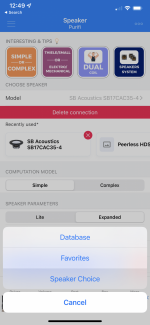
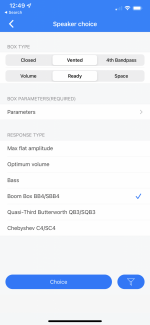
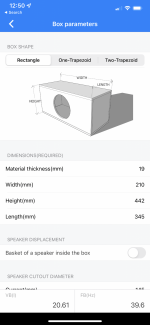
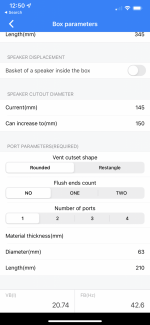
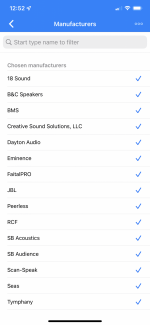
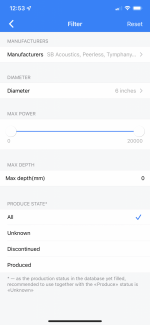
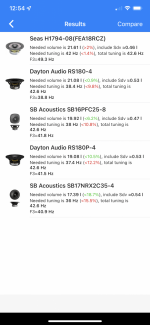
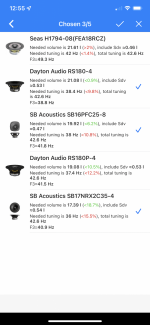
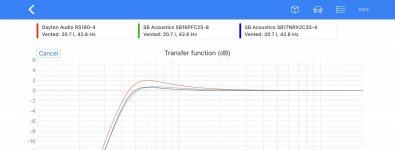
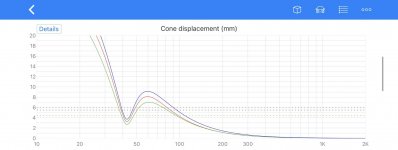
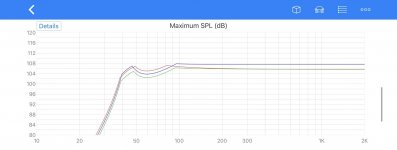
In terms of LF the cone material doesn't matter much because the drivers are pistonic more or less, which means in a cabinet they are all flat and smooth frequency response and omnidirectional out to about 200Hz (~300Hz if you accept a -3dB point at 90 degrees)
Power handling is related to voice coil size and advanced features that cool the voice coil. I always prefer speaker with demodulation devices like copper or aluminum sleeves or shorting rings, but it is important to remember that the soft parts design eg. spider, surround perhaps plays a more important part in non-linear distortion particularly as the cone movement increases (at low frequencies or higher SPLs)
Last edited:
I have no affiliation with speakerboxlite.
But I am a user/fan.
I don’t much like the website; I just use the phone app.
But be warned Vineeth- this is one addictive woofer selection toy!
But I am a user/fan.
I don’t much like the website; I just use the phone app.
But be warned Vineeth- this is one addictive woofer selection toy!
Thanks a lot @fluid and @tktran303 for the crossovers and advice regarding driver selection.. 🙂
I should confess that I made a mistake in measurement, which I realized yesterday while trying to measure the system with crossover applied using a minidsp umik-1.
I forgot to apply mic calibration for my dayton EMM-6 mic using which i took the measurements for the sica coax mid and tweeter. I was hoping that REW will load it automatically since i had uploaded it once sometime back. But due to some reason it didn't.
As a result, there was a downslope of about 6dB from somewhere around 4kHz till 20kHz that was missing in the mid and tweeter data that I had put up earlier. 🙁 Sorry everyone for this mistake.
Yesterday, I got that mic calibration response compensated in vituixCAD calculator tool and generated new polar responses for the drivers. I will update the new data in the google driver folder by today.
After correcting the mistake, using fluid's 3 way crossover from before as reference, I designed a slightly modified crossover for the new responses. The target was to get the responses close to what fluid had designed earlier.
Here is how it looks like:


I think there is still room for improvement on this one compared to the crossover that fluid designed earlier.
I will work on it and also try to adapt the latest crossover that fluid posted above.
I also got an on axis measurement 4ms gated 1 m away from the speaker and it looked like this. Looks much closer to the designed crossover on axis response i think. Earlier there was a big droop down of reponse by about 6-7 dB from 4-5kHz

But for more confirmation I definitely should do more off axis measurements. I thought I will do that once i get some free time from work in coming days.
In the meanwhile, the above crossover, I loaded into DSP and for the first time heard the 3 way system in mono.. 🙂
I am still getting used to the sound (especially going back to mono from stereo).
Next I am attempting to describe about what i heard with this crossover sitting about 2.5m away from the speaker on axis with the coax tweeter. I felt that one thing that stood out is a little bit more treble extension compared to my horn system. It is not a lot but it is definitely there. The other thing is a much more uniform soundfield. I moved far to the left and to the right. Sat closer to the speakers like 1m away and even went back as much as I could (2.5+m). There was not much variation in the sound except for a gentle lowering in tonality and the level of higher frequencies with off axis listening. With the earlier horn system, there was definetely a lot more variation in tonality with on-axis vs further off axis listening. It was sort of like there was a halo around the speaker from which sound was appearing to come from (even in mono). I think these can even be used for nearfield listening. I also felt that these speakers will really really be good to listen to in stereo.. 🙂
Another thing i think i felt was with some male vocals etc, some parts of the sound sustained (not much of an echo but still) a little bit longer? (room contributing bit more to the sound maybe?) One other difference that i having a lot of difficulty explaining is this. With the earlier horn, there was this feeling of power/more energy throughout the vocal range and feeling of sound coming from a bigger speaker. It was like sound washing over the body. With this speaker a bit of that feeling is missing. There is plenty of bass as before but vocals etc dont seem to have as much energy as before and seem to come from a relatively smaller speaker. I don't know why this is the case, whether it is due to 5inch speakers playing part of the frequency range which was earlier taken care of by much bigger drivers? or is it because it was easier to get to much louder volumes earlier with the horn system compared to this? Here I have to crank up the volume much more on the amp. Or is it overall dynamics that the horn was to convay better than a small speaker like this?
Overall, somehow, there is still a longing to go back to the horn system.. But this is still early days and i think i should more carefully study what exactly is happening and do level matched listening and comparisons between the mono horn system and this mono coax system before making conclusions.. 🙂
PS: Sorry for the long post.. These things are becoming very hard to describe in words.. 🙂 I have also attached the mic calibration file for my mic with this post.
I should confess that I made a mistake in measurement, which I realized yesterday while trying to measure the system with crossover applied using a minidsp umik-1.
I forgot to apply mic calibration for my dayton EMM-6 mic using which i took the measurements for the sica coax mid and tweeter. I was hoping that REW will load it automatically since i had uploaded it once sometime back. But due to some reason it didn't.
As a result, there was a downslope of about 6dB from somewhere around 4kHz till 20kHz that was missing in the mid and tweeter data that I had put up earlier. 🙁 Sorry everyone for this mistake.
Yesterday, I got that mic calibration response compensated in vituixCAD calculator tool and generated new polar responses for the drivers. I will update the new data in the google driver folder by today.
After correcting the mistake, using fluid's 3 way crossover from before as reference, I designed a slightly modified crossover for the new responses. The target was to get the responses close to what fluid had designed earlier.
Here is how it looks like:
I think there is still room for improvement on this one compared to the crossover that fluid designed earlier.
I will work on it and also try to adapt the latest crossover that fluid posted above.
I also got an on axis measurement 4ms gated 1 m away from the speaker and it looked like this. Looks much closer to the designed crossover on axis response i think. Earlier there was a big droop down of reponse by about 6-7 dB from 4-5kHz
But for more confirmation I definitely should do more off axis measurements. I thought I will do that once i get some free time from work in coming days.
In the meanwhile, the above crossover, I loaded into DSP and for the first time heard the 3 way system in mono.. 🙂
I am still getting used to the sound (especially going back to mono from stereo).
Next I am attempting to describe about what i heard with this crossover sitting about 2.5m away from the speaker on axis with the coax tweeter. I felt that one thing that stood out is a little bit more treble extension compared to my horn system. It is not a lot but it is definitely there. The other thing is a much more uniform soundfield. I moved far to the left and to the right. Sat closer to the speakers like 1m away and even went back as much as I could (2.5+m). There was not much variation in the sound except for a gentle lowering in tonality and the level of higher frequencies with off axis listening. With the earlier horn system, there was definetely a lot more variation in tonality with on-axis vs further off axis listening. It was sort of like there was a halo around the speaker from which sound was appearing to come from (even in mono). I think these can even be used for nearfield listening. I also felt that these speakers will really really be good to listen to in stereo.. 🙂
Another thing i think i felt was with some male vocals etc, some parts of the sound sustained (not much of an echo but still) a little bit longer? (room contributing bit more to the sound maybe?) One other difference that i having a lot of difficulty explaining is this. With the earlier horn, there was this feeling of power/more energy throughout the vocal range and feeling of sound coming from a bigger speaker. It was like sound washing over the body. With this speaker a bit of that feeling is missing. There is plenty of bass as before but vocals etc dont seem to have as much energy as before and seem to come from a relatively smaller speaker. I don't know why this is the case, whether it is due to 5inch speakers playing part of the frequency range which was earlier taken care of by much bigger drivers? or is it because it was easier to get to much louder volumes earlier with the horn system compared to this? Here I have to crank up the volume much more on the amp. Or is it overall dynamics that the horn was to convay better than a small speaker like this?
Overall, somehow, there is still a longing to go back to the horn system.. But this is still early days and i think i should more carefully study what exactly is happening and do level matched listening and comparisons between the mono horn system and this mono coax system before making conclusions.. 🙂
PS: Sorry for the long post.. These things are becoming very hard to describe in words.. 🙂 I have also attached the mic calibration file for my mic with this post.
Attachments
Last edited:
These recent XO results are impressive. Big question is whether that big dip just past 10 khz is audible or to say it differently if and how much it detracts from the SQ?
HiThese recent XO results are impressive. Big question is whether that big dip just past 10 khz is audible or to say it differently if and how much it detracts from the SQ?
Do you have any suggestion on how I can test it..?
Using sine sweeps first and seeing if there is any relative amplitude difference noticeable with that dip vs without that dip?
Thanks
Vineeth
- Home
- Loudspeakers
- Multi-Way
- A 3 way design study
